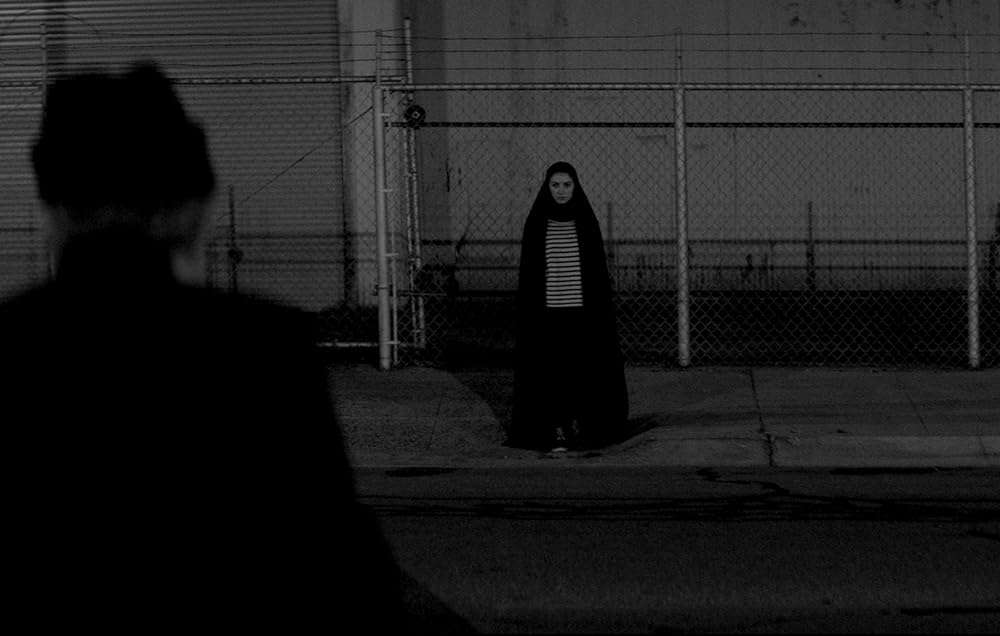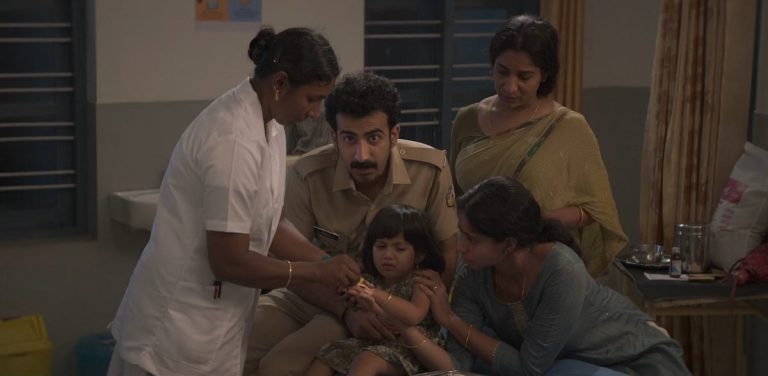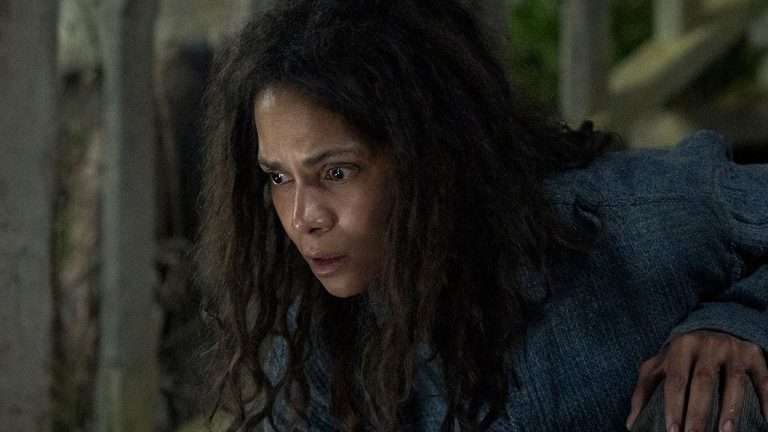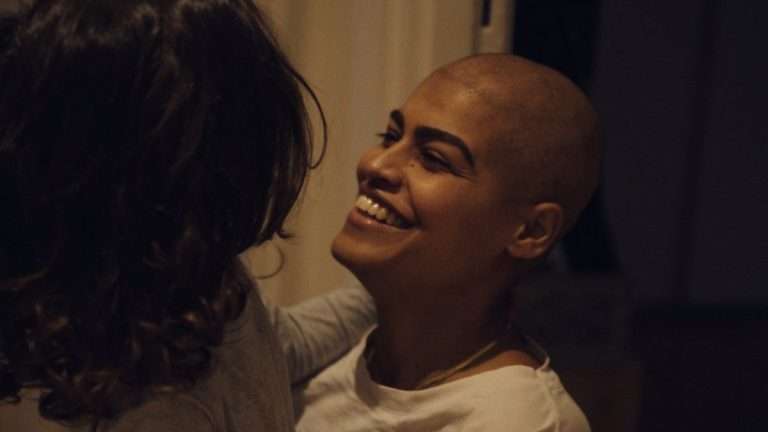In 2014, Ana Lily Amirpour’s “A Girl Walks Home Alone At Night” was released. This Persian-language, black-and-white, vampire western delves into the complexities of gender dynamics against the backdrop of the fictional Iranian oil town, ‘Bad City.’ This feminist cinematic masterpiece is a vital work to reflect upon and revisit, given the prescience of the film’s title with regards to the recent wave of protests in Iran – also known as ‘The Girls of Revolution Street.’
Our lonesome protagonist is a vampire called simply ‘The Girl’(Sheila Vand) who traverses a ghost town, killing the abusive, patriarchal men who cross her path. She acts as a ‘guardian vampire’ for the mistreated sex worker, Atti (Mozhan Marnò), and uses her perceived weakness to her advantage when killing the aggressive pimp Saeed (Dominic Rains). ‘The Girl’ even murders the father of her newfound lover, Arash (Arash Marandi), who is unaware of The Girl’s vampiric qualities.
Amirpour is a British-born, American-Iranian director who combines her nationalities as fluidly and naturally as she mixes genres. “A Girl Walks Home Alone At Night” has been called a reimagining of the American Gothic by some, by others, an “Iranian vampire spaghetti Western.” Effortlessly cool, this genre-bending film – set in Iran and shot in Los Angeles – weaves a feminist sentiment into the plot in a beautifully simple and understated manner. Amirpour has, however, commented that the film wasn’t made with a feminist intention.
Despite this, gender relations fuel all acts of violence and the majority of – if not all – plot points within the film. It feels impossible to watch our solitary, small figure of The Girl skate through Bad City (on a skateboard she steals from a young boy as she warns him not to be bad), fighting against aggressive male acts, and not feel that Amirpour is making a statement about reclaiming the public space of the street for women.
The world of Bad City offers an alternate reality in which women are safe from patriarchy and retaliate to oppression through violence of their own. ‘The Girl’ is by no means a cliched ‘strong woman’ but a fascinatingly fluid, unbelievably cool character with an excellent record collection and a fantastic bedroom. In one of the film’s mesmerizing dance scenes, The Girl smears dark eyeliner and lipstick messily over her lips and eyes and slowly circles and spins her body in time to the music. Amirpour emphasizes The Girl’s sense of self through her dancing, her choice of music, and her subversion of the act of putting on makeup. This is underlined by the incredible personality of The Girl’s Bedroom; feminist critique has often cited the bedroom as a space of female identity and power.
The simplicity in naming places and people in the film also leans towards a feminist interpretation. ‘The Girl’ can be read as representing a universal female experience of wandering every day through ‘bad cities,’ which are filled with the kinds of gender-based violence and fear experienced daily in women’s lives. It is important to underscore the universality of the way in which women and female-identifying people the world over suffer from a lack of access to public spaces for fear of patriarchal retaliation. To fully understand the film’s significance, however, it is vital to go beyond that universality and situate “A Girl Walked Home Alone At Night” within the specificity of its Iranian context.

Iranian cinema has long been a powerful tool for social commentary and critique. A nuanced exploration of gender roles has marked Iran’s rich cinematic tradition, and feminist Iranian cinema as a genre has consistently challenged societal norms. The term ‘feminism’ first made its way into Iranian cultural discourse with the publication of the first women’s newspaper, Danesh, in 1910. This marked a significant moment for women’s rights, as Iranian women were able to take on roles of public authorship, which built upon the momentum that already established women’s rights groups had made. However, Ayatollah Khomeini’s revolution in 1979 significantly disrupted the progress that the feminists had made, enforcing significant levels of repression. Despite the adversity and oppression, countless female filmmakers have not stopped documenting their lives and creating radical artwork on screen.
All the way back in 1962, for instance, Forough Farrokhzad’s “The House is Black” is credited with having kickstarted the Iranian New Wave. Other noteworthy Iranian feminist films include Rakhshan Bani-Etemad’s 1991 film “Nargees,” which documents the experiences of homeless women and exemplifies the director’s commitment to social realism and portraying the lives of the disenfranchised. Marzieh Meshkini’s “The Day I Became a Woman” (2000) and Samira Makmalbaf’s “The Apple” (1998) are also must-watches. More recently, Marjane Satrapi’s “Persepolis” (2007) gained significant acclaim for its portrayal of contemporary Iranian politics.
“A Girl Walks Home Alone At Night” contributes to this long history of feminist Iranian cinema. Its focus on female power in the public space of the street is especially significant when looking at Iran today. It has been around a year and a half since Mahsa Amini’s death in police custody sparked the most significant wave of widespread unrest that the country had seen for years. The morality police in Tehran arrested Amini for allegedly not complying with Article 638 of the Islamic penal code, which states that it is a crime for women to appear in public without an Islamic hijab. Although Amirpour’s film does not directly tackle issues of the morality police or state repression, it is nevertheless a poignant, cinematically beautiful reflection upon women’s place in public spaces.
In the context of the Mahsa Amini protests and the continued violent struggle against the oppressive Iranian regime, it is vital that we continue to talk about the women who remain at the forefront of the “Women, Life, Freedom” revolution, which is still taking place. A key means of understanding and learning more about their struggle, politics, and history is to listen to the voices from Iran and the diaspora community, to look at and reflect upon their art, literature, and – of course – cinema.







![Killing (Zan) [2019]: ‘Japan Cuts’ Review – A Remarkable Reimagining of Samurai Cinema Tropes](https://79468c92.delivery.rocketcdn.me/wp-content/uploads/2019/07/Killing-2018-768x432.jpg)